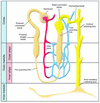Negative regulators of sodium transport in the kidney: key factors in understanding salt-sensitive hypertension?
- PMID: 12671041
- PMCID: PMC152592
- DOI: 10.1172/JCI18232
Negative regulators of sodium transport in the kidney: key factors in understanding salt-sensitive hypertension?
Figures


Comment on
-
WNK kinases regulate thiazide-sensitive Na-Cl cotransport.J Clin Invest. 2003 Apr;111(7):1039-45. doi: 10.1172/JCI17443. J Clin Invest. 2003. PMID: 12671053 Free PMC article.
References
-
- Guyton AC. Blood pressure control - Special role of the kidneys and body fluid. Science. 1991;252:1813–1816. - PubMed
-
- Lifton RP, Gharavi AG, Geller DS. Molecular mechanisms of human hypertension. Cell. 2001;104:545–556. - PubMed
-
- Achard JM, Disse-Nicodeme S, Fiquet-Kempf B, Jeunemaitre X. Phenotypic and genetic heterogeneity of familial hyperkalaemic hypertension (Gordon syndrome) Clin. Exp. Pharmacol. Physiol. 2001;28:1048–1052. - PubMed
-
- Wilson FH, et al. Human hypertension caused by mutations in WNK kinases. Science. 2001;293:1107–1112. - PubMed

